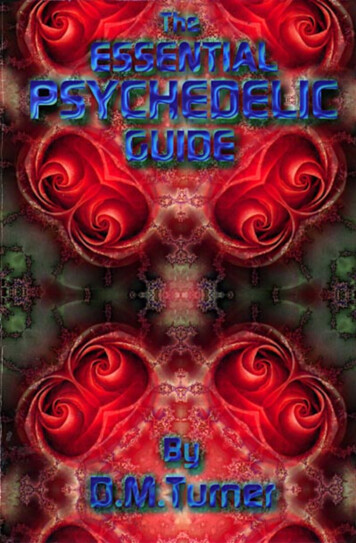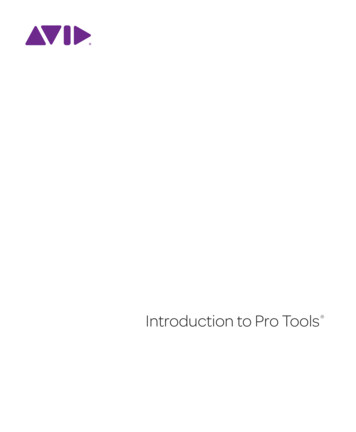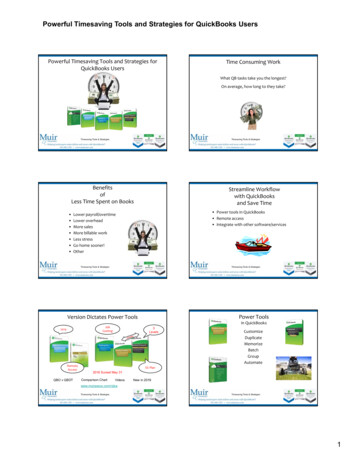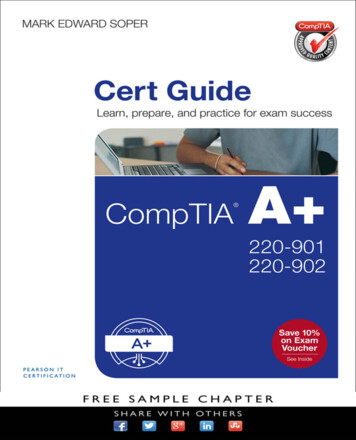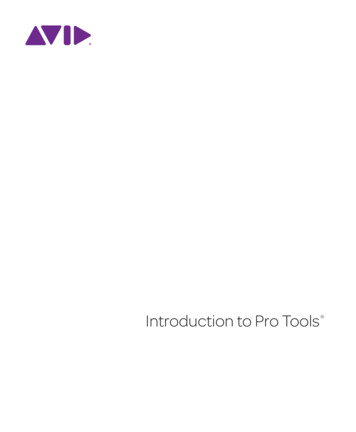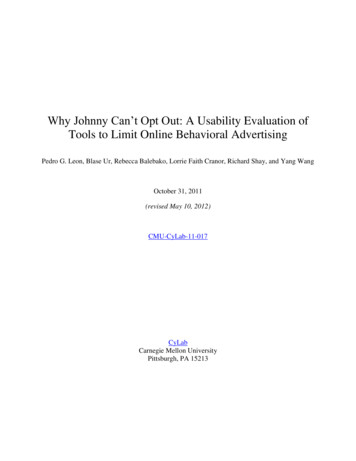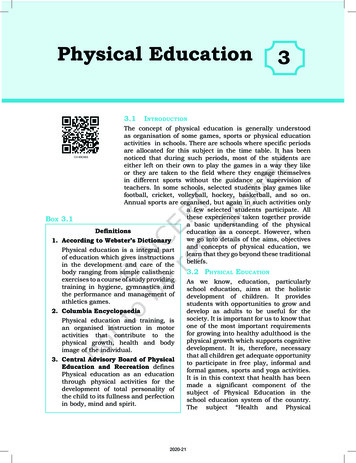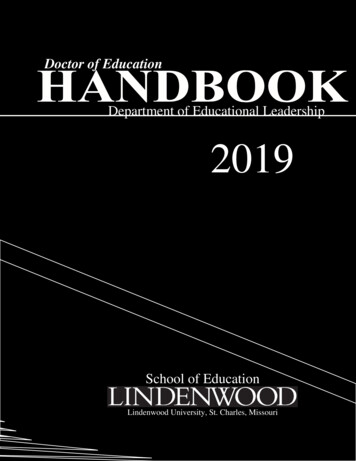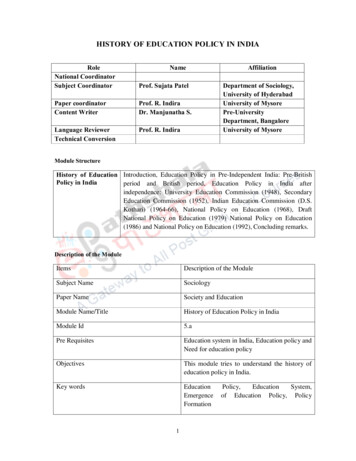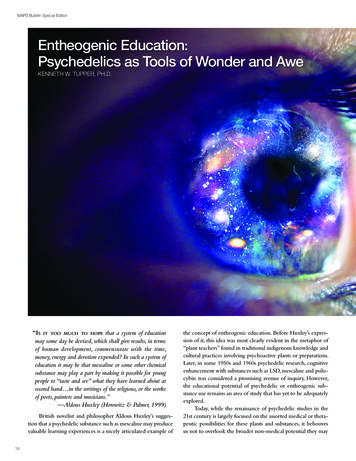
Transcription
MAPS Bulletin Special EditionEntheogenic Education:Psychedelics as Tools of Wonder and AweKENNETH W. TUPPER, PH.D.“IS IT TOO MUCH TO HOPE that a system of educationmay some day be devised, which shall give results, in termsof human development, commensurate with the time,money, energy and devotion expended? In such a system ofeducation it may be that mescaline or some other chemicalsubstance may play a part by making it possible for youngpeople to “taste and see” what they have learned about atsecond hand in the writings of the religious, or the worksof poets, painters and musicians.”—Aldous Huxley (Horowitz & Palmer, 1999)British novelist and philosopher Aldous Huxley’s suggestion that a psychedelic substance such as mescaline may producevaluable learning experiences is a nicely articulated example of14the concept of entheogenic education. Before Huxley’s expression of it, this idea was most clearly evident in the metaphor of“plant teachers” found in traditional indigenous knowledge andcultural practices involving psychoactive plants or preparations.Later, in some 1950s and 1960s psychedelic research, cognitiveenhancement with substances such as LSD, mescaline and psilocybin was considered a promising avenue of inquiry. However,the educational potential of psychedelic or entheogenic substance use remains an area of study that has yet to be adequatelyexplored.Today, while the renaissance of psychedelic studies in the21st century is largely focused on the assorted medical or therapeutic possibilities for these plants and substances, it behoovesus not to overlook the broader non-medical potential they may
Spring 2014Photo credit: ImaginaryFoundation.comhave for learning and cognition. In what follows, I briefly summarize some of the historical and cross-cultural foundationsof entheogenic education and explore how psychedelic substances—used in careful ways and supportive contexts—mightfill a gap in the learning outcomes and psychosocial effects ofmodern school-based education, in particular fostering theemotions of wonder and awe and their relationship to creativity,life meaning, and purpose.THE ORIGINSOF ENTHEOGENIC EDUCATIONThe notion that some psychoactive plants can help humanslearn important things about the cosmos and their place in it isa belief held by many different cultures. At the roots of modernKenneth W. Tupper, Ph.D.Western culture, for example, the Indo-Aryan Vedic scripturesmake abundant reference to the spiritual or mystical importanceof a plant or fungus known as soma. Referred to in both cosmicand biological metaphorical terms, partaking of soma was venerated as the highest form of spiritual understanding one couldachieve, a prime example of entheogenic learning (Wasson,1968). Likewise, the ancient Greek mystery religion of Eleusisculminated in the ritual consumption of kykeon, surmised to besome kind of psychoactive preparation that could reliably induce mystical states of consciousness and a kind of learning thatwas celebrated among all classes of Athenian society (Wasson,Hofmann, & Ruck, 1978). Even within the Judeo-Christiantradition, the Semitic origin myth recounted in the book ofGenesis allegorically suggests an instance of entheogenic learn15
MAPS Bulletin Special Editioning, whereby eating the fruit of the tree of knowledge inspiredhuman self-consciousness and divine awakenings.In the Americas, there have been more enduring examplesof entheogenic educational practices, some of which managedto survive into the modern era despite repression by Euroamerican colonial religious and government authorities. For example, the traditional Mazatec usesof psilocybin mushrooms werecontinued by people like curandera Maria Sabina, who said ofearly encounters with her “littlechildren” (a phrase she used torefer to the mushrooms): “I feltthat they spoke to me. After eating them I heard voices. Voicesthat came from another world.It was like the voice of a fatherwho gives advice Sometimelater I knew that the mushrooms were like God. That theygave wisdom” (Estrada, 1981, pp. 39–40). Similar educationalvalue has been accorded to the peyote cactus, as a Mexican indigenous Huichol person relates: “Peyote is for learning; thosewith strong hearts will receive messages from the gods” (Shaefer,1996, p. 165).Among Amazonian indigenous and mestizo peoples, thevisionary entheogenic brew ayahuasca has long been esteemedas a plant teacher (Luna, 1984), a categorical testimony to theeducational value of its psychoactive effects. Mestre Irineu,the spiritual founder of the Brazilian ayahuasca religion SantoDaime, in his early formative experiences reportedly “learnedthat the daime [i.e., ayahuasca], besides being a visionary drink,also had special healing powers and that it contained um professor, a teacher, capable of revealing secrets about the spiritualworld” (Schmidt, 2007, p. 52). From a more academic perspective, cognitive psychologist Benny Shanon notably proffers a“schooling” metaphor for the sustained practice of ayahuascadrinking, and reports that he has heard the same characterization of a sense of systematized learning from other experiencedayahuasca drinkers (Shanon, 2002, pp. 301–3).Claims of mind expansion, cognitive enhancement, andcreative insights among modern psychedelic researchers and enthusiasts further support the concept of entheogenic education.Perhaps most famously, Timothy Leary (1968) advocated thebenefits of LSD and other psychedelics for mind-expansion andthe democratization of mystical experience. However, cognitive, creative, and spiritual development were significant themesin the academic work of many early psychedelic researchersand aficionados in the 1950s and 1960s (Walsh & Grob, 2005).More recently, others—including scientists, artists, musiciansand business leaders—have likewise attributed some of theirmost important intellectual and creative insights to their usesof entheogens or psychedelics (Mullis, 1998; Isaacson, 2011;Markoff, 2005).More explicitly in the field of education, teacher and education researcher Ignacio Götz argued in his 1972 book ThePsychedelic Teacher that students would be better served by teachers who adopt a personal approach to knowing and learningthat embraces mystical or “psychedelic” states of consciousness.Emeritus professor of education Thomas Roberts (2006)has argued that conventionalcognitive science and educationlargely fail to recognize that thehuman “mindbody” (his termfor states of consciousness) is capable of a diversity of valences,and that entheogens are an important means producing nonordinary states of consciousness,by which creative, intellectual,or spiritual development maybe stimulated. The ritual use ofpsychoactive substances for learning and developmental purposes was explored in an earlier special edition of the MAPSBulletin (2004), titled “Rites of Passage: Kids and Psychedelics.”The educational value of entheogensand psychedelics may be theircapacity to reliably evoke experiencesof wonder and awe, to stimulatetranscendental or mystical experiences,and to catalyze a sense of lifemeaning or purpose.16THE ACADEMICPSYCHEDELIC RENAISSANCEThe renaissance of academic interest in psychedelics in the early21st century has already generated intriguing new empiricalevidence about these substances and their potential benefits forlearning and psychosocial flourishing. For example, researchersat Johns Hopkins University have corroborated earlier scientificfindings that psilocybin administered in a clinical setting canproduce mystical-type experiences that have substantial andsustained personal meaning and spiritual significance (Griffiths,et al., 2008). They also found that the psilocybin-inducedmystical experience produced a greater degree of openness inadults, which can in turn correlate with changes in behaviors,attitudes, and values, an unusual psychological phenomenon tosee in older people. Similarly, research on healthy people whodrink ayahuasca in ritual contexts suggests that spiritual insights,changed worldviews, and a new more positive orientation towards life are not uncommon outcomes (Bouso, et al., 2012;Grob, et al., 1996; Halpern, et al., 2008). These phenomena helpaccount for not only the medicinal or healing properties ofpsychedelics, but also their possible spiritual, cognitive enhancement, or educational value.To explain how and why entheogenic or psychedelic experiences can be educational ones, and to advance a programof further research in this area, the development of a coherenttheoretical framework for entheogenic education is required.My own scholarly effort in this area has been to adapt ideasfrom contemporary educational and psychological theoristswhose work, while not explicitly about psychedelics, can helpsupport an explanatory account of entheogenic education. Forexample, Howard Gardner’s theory of multiple intelligences
Spring 2014criticized conventional ideas about intelligence, which focuslargely on mathematical and linguistic kinds, and alternativelyproposed a variety of others (1983), later including what hedescribed as “existential intelligence” (1999).While Gardner hashimself expressed ambivalence about existential intelligence, Ihave argued that conceiving of psychedelic plants or substancesas cognitive tools helps both to strengthen the case for its validity and to illuminate the potential educational benefits of entheogenic substance use (2002). I have also drawn on the education theories of Kieran Egan (1997), and philosophical ideas ofRichard Shusterman (2008), to argue that the circumspect useof entheogens can be understood as the deployment of cognitive tools to catalyze what Egan describes as primordial types ofunderstanding, the (pre-linguistic) somatic and the (pre-literate)mythic (Tupper, 2003). In my Ph.D. dissertation in EducationalStudies at the University of British Columbia, the final chapter further developed some of the conceptual foundations forunderstanding the education potential of entheogens such asayahuasca (2011).WONDER AND AWEIN ENTHEOGENIC EDUCATIONThe potential value of entheogens in the domain of educationcan be further elucidated by considering how experiences ofwonder and awe—phenomenological markers of both mysti-Looking for more ways toget involved?Learn aboutpsychedelic researchwhile helping create subtitlesfor videos fromcal and psychedelic experiences—are neglected in the culturalinstitution of modern schooling. Although historically underappreciated in psychological research, the emotions of wonder andawe may be crucial components of moral, spiritual, and aestheticdomains of human cognition (Keltner & Haidt, 2003). For example, Robert Fuller (2006, p. 157) asserts that wonder:is characterized by its rare ability to elicit prolongedengagement with life. Experiences of wonder succeed inmotivating creative and constructive approaches to life byimbuing the surrounding world with an alluring luster.Experiences of wonder enable us to view the world independent of its relationships to our immediate needs.In his earlier work on imagination and education, Egan(1992) argues that experiences of wonder and awe are essentialto stimulating imagination and cultivating a meaningful life, thatone’s creativity, educational development, and self-actualizationare impoverished without them. Environmental educator David Orr (1994, p. 23) concurs, suggesting that “[a]s our senseof wonder in nature diminishes, so too does our sense of thesacred, our pleasure in the created world, and the impulse behind a great deal of our best thinking.” And psychologist MartinSeligman (2011) suggests that late modern materialist consumerism may be linked to a growing lack of existential meaningand psychological flourishing among American youth.CONNECTwith MAPSStay up-to-date and be a part of the growing psychedelicand medical marijuana research community.MAPS Email Newslettermaps.org/newsletterWorld Wide Webmaps.orgJoin our caption and translationvolunteer team atWe already have over 200 e.com/mapsmdmaWill you join our team?maps.org/amaraTwittertwitter.com/mapsnews17
MAPS Bulletin Special EditionDeriving meaning, purpose, and satisfaction from life mustbe considered among the highest goals of human existence, andas Keichi Takaya (2014, p. 99) argues, “keeping the ability to feelwonder itself ought to be an important part of the purpose ofeducation.” However, contemporary school-based education—and the broader socio-economic environment in which it issituated—does very little explicitly to foster such outcomes. Asan institution rooted in the 19th century political and militaryambitions of nation states (Ramirez & Boli, 1987), the modernschool today remains heavily invested in structures, processesand programs that tend to sustain a long-standing antipathy towonder and awe in modern Western culture (Egan, 1997; Daston & Park, 1998). This, in part, may be what Aldous Huxleywas referring to in the introductory quotation lamenting whatschools deliver in terms of existential meaning (Horowitz &Palmer, 1999), and what inspired him to explore the idea ofentheogenic education—through a description of the use of apsychoactive mushroom used in rites of passage into adulthoodin the fictional society of Pala—in his final novel, Island (1962).The educational value of entheogens and psychedelics maybe their capacity—when used respectfully and circumspectly—to reliably evoke experiences of wonder and awe, to stimulatetranscendental or mystical experiences, and to catalyze a senseof life meaning or purpose. The careful and elaborate ritualtraditions of various indigenous entheogenic practices withplant teachers have long betokened how entheogenic education can be realized in practice. Most notably, such traditionstypically emphasize the importance of context and intention,with stringent protocols for who may participate, what kindand how much of a psychedelic substance they take, and underwhat circumstances the experience occurs. Deploying thesekinds of powerful cognitive tools for educational purposes inthe 21st century will require equivalent care and attention toimplementing these kinds of proto-harm reduction conventions. Exploring and extending the possibilities of entheogeniceducation may be an important way for humans to adapt, flourish, and psychologically thrive even as we face unprecedentedchallenges—such as ecological limits to growth—in the nottoo-distant future.REFERENCESBouso, J. C., González, D., Fondevila, S., Cutchet, M.,Fernández, X., Barbosa, P. C. R., et al. (2012). Personality,psychopathology, life attitudes and neuropsychological performance among ritual users of ayahuasca: A longitudinal study.PLoS ONE, 7(8), e42421.Daston, L., & Park, K. (1998). Wonders and the order of nature1150-1750. New York: Zone Books.Egan, K. (1992). Imagination in teaching and learning: Themiddle school years. Chicago: University of Chicago Press.Egan, K. (1997). The educated mind: How cognitive tools shapeour understanding. Chicago, IL: University of Chicago Press.Estrada, Á. (1981). María Sabina: Her life and chants. (H.Munn, Trans.). Santa Barbara, CA: Ross-Erikson.18Fuller, R. C. (2006). Wonder: From emotion to spirituality.Chapel Hill, NC: University of North Carolina Press.Gardner, H. (1983). Frames of mind: The theory of multipleintelligences. New York: Basic Books.Gardner, H. (1999). Are there additional intelligences? In J.Kane (Ed.), Education, information, transformation: Essays on learning and thinking (p. 111–131). Upper Saddle River, NJ: PrenticeHall.Götz, I. L. (1972). The psychedelic teacher: Drugs, mysticism,and schools. Philadelphia, PA: Westminster Press.Griffiths, R., Richards, W., Johnson, M., McCann, U., &Jesse, R. (2008). Mystical-type experiences occasioned by psilocybin mediate the attribution of personal meaning and spiritualsignificance 14 months later. Journal of Psychopharmacology, 22(6),621–632.Grob, C. S., McKenna, D. J., Callaway, J. C., Brito, G. S.,Neves, E. S., Oberlander, G., et al. (1996). Human psychopharmacology of hoasca, a plant hallucinogen used in ritual contextin Brazil. The Journal of Nervous and Mental Disease, 184(2),86–94.Halpern, J. H., Sherwood, A. R., Passie, T., Blackwell, K.C., & Ruttenber, A. J. (2008). Evidence of health and safety inAmerican members of a religion who use a hallucinogenic sacrament. Medical Science Monitor, 14(8), SR15–SR22.Hanna, J., & Thyssen, S. (Eds.). (2004). Rites of passage:Kids and psychedelics [Electronic Version]. MAPS Bulletin, 14.Retrieved from rowitz, M., & Palmer, C. (Eds.). (1999). Moksha: AldousHuxley’s classic writings on psychedelics and the visionary experience.Rochester,VT: Park Street Press.Huxley, A. (1962). Island. New York: Harper & RowIsaacson, W. (2011). Steve Jobs. New York: Simon & Schuster.Keltner, D., & Haidt, J. (2003). Approaching awe, a moral,spiritual, and aesthetic emotion. Cognition & Emotion, 17(2),297-314.Leary, T. F. (1968). The politics of ecstasy. New York: Putnam.Luna, L. E. (1984a). The concept of plants as teachersamong four mestizo shamans of Iquitos, northeastern Peru.Journal of Ethnopharmacology, 11(2), 135–156.MacLean, K. A., Johnson, M. W., & Griffiths, R. R. (2011).Mystical experiences occasioned by the hallucinogen psilocybinlead to increases in the personality domain of openness. Journalof Psychopharmacology, 25(11), 1453–1461.Markoff, J. (2005). What the dormouse said: How the sixtiescounterculture shaped the personal computer industry. New York:Viking.Mullis, K. (1998). Dancing naked in the mind field. New York:Pantheon Books.Orr, D. W. (1994). Earth in mind: On education, environment,and the human prospect. Washington, DC: Island Press.Ramirez, F. O., & Boli, J. (1987). The political constructionof mass schooling: European origins and worldwide institution-
Spring 2014alization. Sociology of Education, 60(1), 2–17.Roberts, T. (2006). Psychedelic horizons. Charlottesville, VA:Imprint Academic.Schaefer, S. B. (1996). The crossing of the souls: Peyote,perception and meaning among the Huichol Indians. In S. B.Schaefer & P.T. Furst (Eds.), People of the peyote: Huichol Indianhistory, religion, & survival. (pp. 138–168.)Albuquerque: Universtity of New Mexico Press.Schmidt, T. K. (2007). Morality as practice: The Santo Daime,an eco-religious movement in the Amazonian rainforest. Uppsala,Sweden: Uppsala University Press.Seligman, M. E. P. (2011). Flourish: A visionary new understanding of happiness and well-being. New York: Free Press.Shanon, B. (2002). The antipodes of the mind: Charting thephenomenology of the ayahuasca experience. Oxford: Oxford University Press.Shusterman, R. (2008). Body consciousness: A philosophy ofmindfulness and somaesthetics. New York: Cambridge UniversityPress.Takaya, K. (2014). Renewing the sense of wonder in theminds of high school and college students. In K. Egan, A. Cant,& G. Judson (Eds.), Wonder-full education: The centrality of wonderin teaching and learning across the curriculum (pp. 97–109). NewYork: Routledge.Tupper, K. W. (2002). Entheogens and existential intelligence: The use of plant teachers as cognitive tools. CanadianJournal of Education, 27(4), 499–516.Tupper, K. W. (2003). Entheogens & education: Exploringthe potential of psychoactives as educational tools. Journal ofDrug Education and Awareness, 1(2), 145–161.Tupper, K. W. (2011). Ayahuasca, entheogenic education &public policy. Unpublished Ph.D. dissertation, University of British Columbia, Vancouver. ch. 6. http://www.kentupper.com/resources/Ayahuasca Entheogenic Educ 26 Public Policy - Tupper 2011.pdfWalsh, R., & Grob, C. S. (Eds.). (2005). Higher wisdom: Eminent elders explore the continuing impact of psychedelics. Albany, NY:State University of New York Press.Wasson, R. G. (1968). Soma: The divine mushroom of immortality. New York: Harcourt Brace Jovanovich.Wasson, R. G., Hofmann, A., & Ruck, C. P. (1978). The roadto Eleusis: Unveiling the secret of the mysteries. New York: HarcourtBrace Jovanovich.Kenneth Tupper has a Ph.D. in Education and is an AdjunctProfessor in the School of Population and Public Health at the University of British Columbia. His research interests include psychedelic studies; cross-cultural and historical uses of psychoactive substances; public,professional and school-based drug education; and developing drug policyfrom a public health perspective. For more information on Kenneth andhis work, see: kentupper.com.Psychedelic Science 2013 videos are available online! Visit maps.org/videos.At Psychedelic Science 2013, over 100 of the world’s leading researchers and more than 1,900international attendees gathered to share recent findings on the benefits and risks of LSD, psilocybin,MDMA, ayahuasca, ibogaine, 2C-B, ketamine, marijuana, and more, over three days of conferencepresentations, and two days of pre- and post-conference workshops.19
ample, Robert Fuller (2006, p. 157) asserts that wonder: is characterized by its rare ability to elicit prolonged engagement with life. Experiences of wonder succeed in motivating creative and constructive approaches to life by imbuing the surrounding world with an alluring luster. Experiences of wonder enable us to view the world inde-

